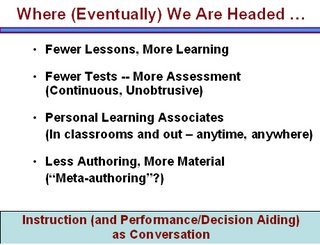This report is a summary of a presentation on “Advanced Technologies for Learning in the Department of Defense” made at the Forum on the Digital Promise, 14 June 2006. Its author is a long time associate J. Dexter Fletcher, a leading researcher of the Institute for Defense Analyses, fletcher@ida.org. Dexter is a Wickenburg native who received his doctorate at Stanford. Knowledge from his many studies has been a major contributor to the design of eSATS for Arizona’s K-12 students.
The reason that military research on eLearning is so important is that they started using analog technology 70 years ago, and digital 30 years ago. Innovation based transformation is usually driven initially by adoption across industries. Here is what IDA and the Office of the Secretary of Defense say about why they are well on the way to totally transform their education and training system.
The DOD spends $16 billion per year for residential instruction; Arizona spends about $10 billion going to $14 billion in ten years. They have 1,300,000 uniformed service members, 750,000 DOD civilians and 80,000 K-12 dependents that must be educated and served with professional development programs. Arizona K-12 has 1 million students and about 60,000 educators.

A typical example of the reach, sophistication and investment by the DoD is their global distributed mission training system. The Air Force Research Laboratory, adjacent to the ASU Polytechnic campus, is a major contributor to this real time simulation and communication system. The eLearning technology leader of the AFRL has been advising and connecting eSATS team members to the latest eLearning research for 15 years.

The golden imperative of eLearning is to provide the means to transform the one teacher – 30 student classroom into a learning environment that supports academic achievement similar to full time tutoring. Fortunately the adoption of the current level of K-12 eLearning digital curriculum and pedagogy gets us half-way there, or one sigma (30% increase in learning or one letter grade improvement.)

For one form of eLearning, CBI, the interactivity emulates the human tutor.

The old text based CBI of the 1980’s gets better each decade as multimedia and intelligent systems add simulation, rich knowledge sources, scaffolding, exploratory and constructivist learning, and real time formative assessment.

The decreased time to learn required K-12 academics can shave years off the current 13 calendar years of K-12 education, and provides enrichment and arts opportunities.

The real payoff of eLearning in K-12 is dropout reduction by 90% (maybe), extraordinary achievement by motivated students ready for college, and major cost savings that free up funds to bring educator salaries up to a professional level.

These “eventualities” are all built into the eLearning Systems for Arizona Teachers and Students design (Circa 2003) with its Personal Learning Plan being launched statewide in Arizona.

Arizona also has these pieces for K-12 education. eSATS has assembled them into a systems design with will engage every student in every classroom.

Math and science has emerged as a critical issue in Arizona at the highest policy levels. The 2006 SB1512 has legislated a three year $3million eLearning middle school math pilot for 10,000 Arizona students. The Arizona Business and Education Coalition, Governor’s P-20 Council and many others have math and science as a major policy initiative. One stand deviation in math is the absolutely lowest goal for Arizona education. The adoption of eLearning is the only possible cost effective way to achieve this goal.

















